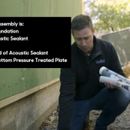Foundation-to-Wall Air Sealing
We are in climate zone 2 and trying to finalize on the build details. Originally I thought to implement the idea of sandwiching acoutical sealant in between the concrete slab foundation and sill sealer and also between the sill sealer and bottom plate; I’ve also thought to maybe try the “monopoly framing” to have the sheathing continuously going up the wall to the roof.
My builder says this is overkill as any air leakage would be taken care of by the HVAC system. We will have open cell spray foam insulation and unvented attic space. Closed cell foam is out of the question. Is he right?
We are also considering adding exterior rigid foam insulation over the Zip sheathing (NOT planning on using the Zip panels that have insulation embedded in it which they call the Zip R). Which product and thickness should I go with? Or should we also skip this step also and use the money elsewhere in the build?
GBA Detail Library
A collection of one thousand construction details organized by climate and house part











Replies
Beedigs,
It's true that the HVAC could be up-sized to account for the leakiness of your building envelope. But if you are trying to NOT waste energy, you want to make the house as tight as possible.
Spray foam isn't magic. It's actually better to use tape and caulk rather than relying on this type of petroleum product. On the exterior foam, it is not required in your climate zone. But some thickness of foam probably would make it easier to create a better performing (say R-20) wall.
Have you already hired this builder? It sounds like you will spend the entire project arguing with him over what's needed and what's overkill. You'd be better off hiring somebody who understands building science and shares your objectives.
I agree with Steve--if your builder's mentality is that the HVAC will take care of air leakage problems, you would be better served with one who is up on modern practices. Encouraging air leakage when tapes and sealants are readily available and affordable is not a good approach.
Specifically for wall-to-foundation sealing, I like Siga Fentrim tape--it's incredibly sticky, quite durable and vapor-permeable.
@Michael Maines - assuming you use Siga Fentrim tape on the outside, do you still use a strip of (acoustical sealant) on one or both sides of the sill seal/capillary break? Are gaskets overkill in your opinion when using a good tape on the outside?
Andrew, I use many different assemblies, depending on the project, what the contractor is familiar with and what new techniques I want to try. I often run the sub-slab vapor retarder over the top of the foundation wall so a separate sill sealer is not necessary. For more conventional foundations and crawlspaces, if there is not a capillary break at the footing (residential concrete contractors will not do this, I've found) I like to use Vycor over the top of the wall instead of the typical foam sill sealer.
I don't use acoustical sealant anywhere, but do recommend Pro Clima Contega HF as an environmentally- and installer-friendly alternative. I don't think it's necessary if you also have a high-quality taped connection on the exterior, as you only need one continuous air control layer, but it wouldn't hurt anything to use sealant as backup.
I've used this for the seal between bottom plate and slab: http://www.conservationtechnology.com/building_gaskets.html
Worked quite well without the mess that acoustic sealant can create.